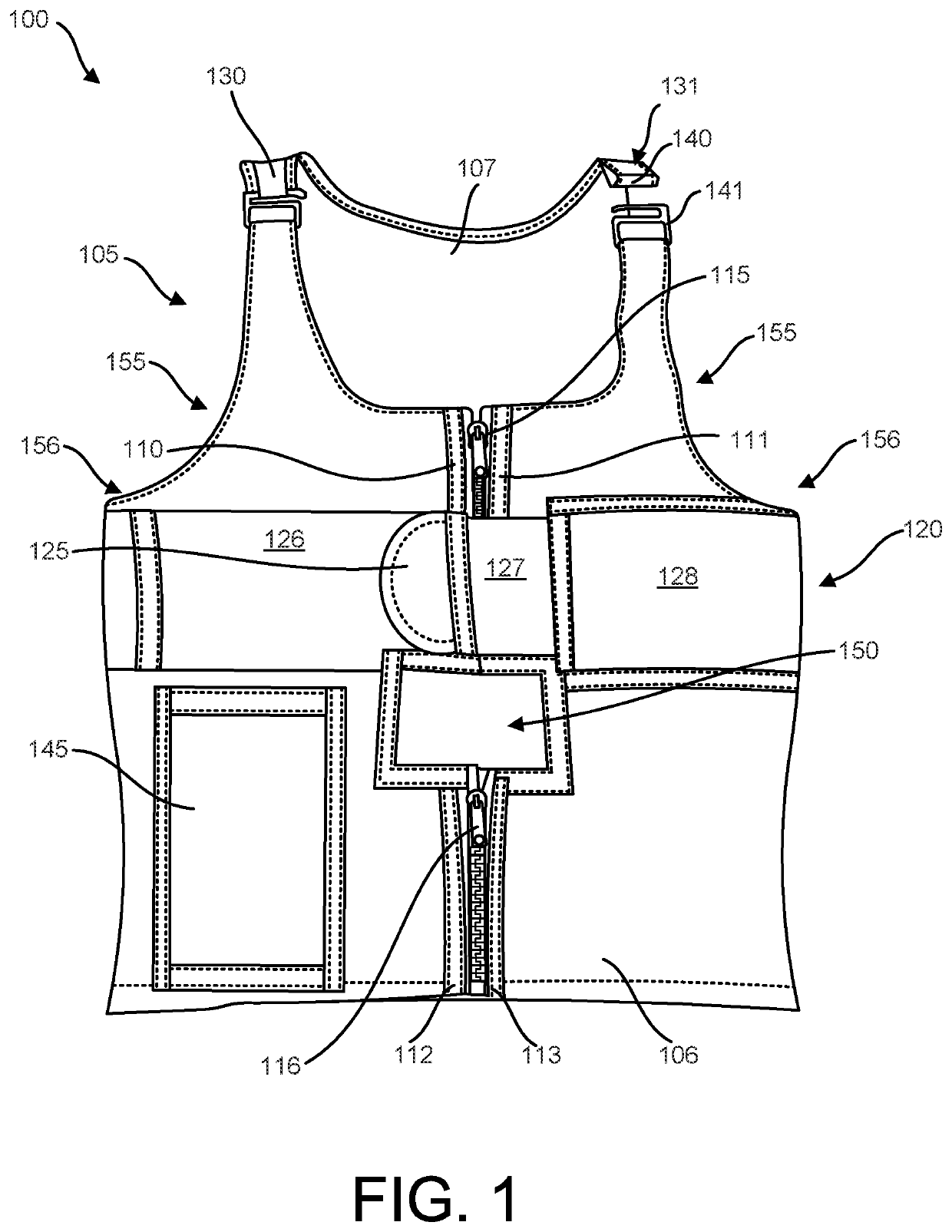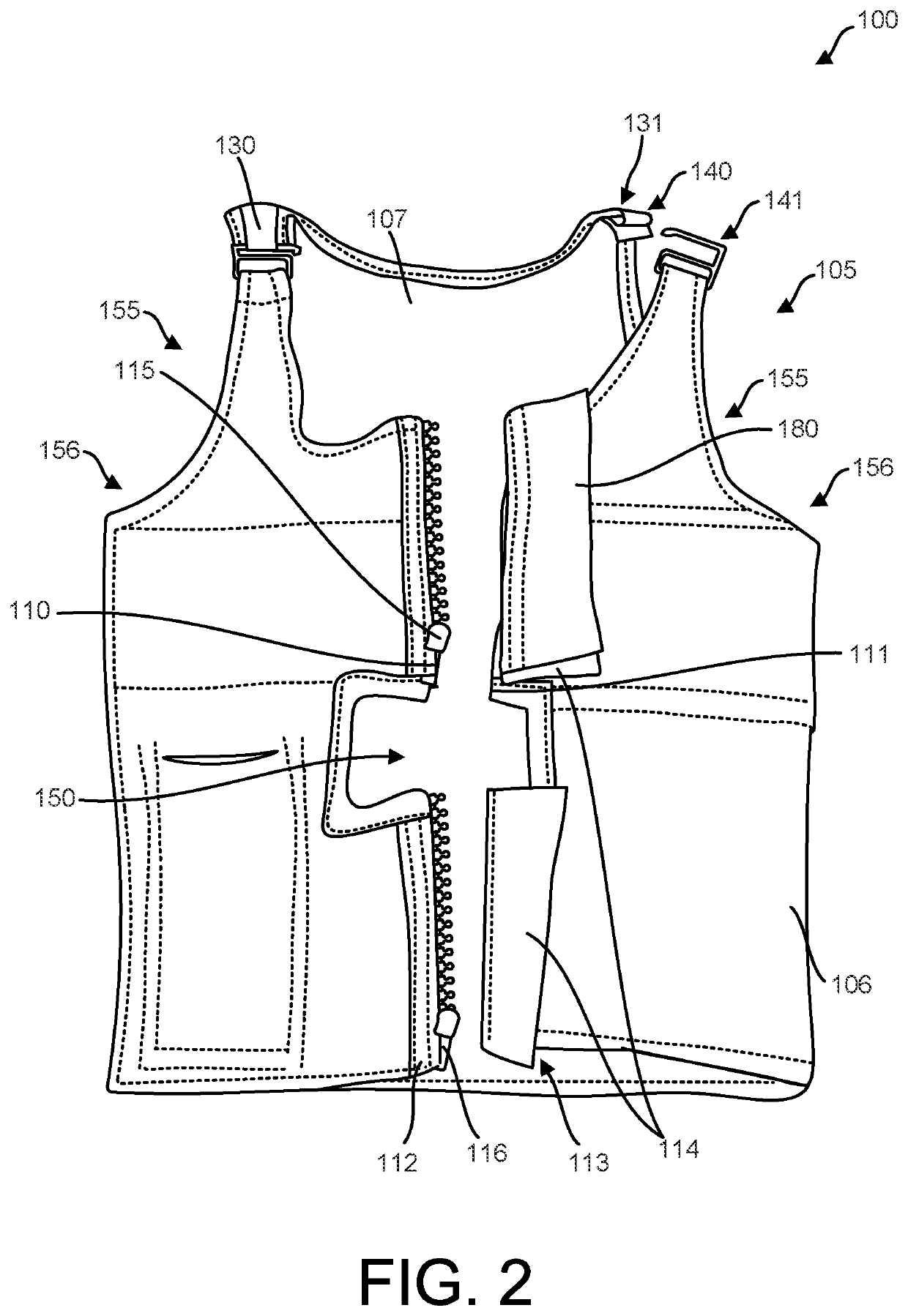Garment for promoting post-surgical recovery
a post-surgical recovery and bracing technology, applied in the field of braces, can solve the problems of long and painful recovery, pain and harm to patient recovery, and devices have offered a more limited ability to facilitate several aspects of improved patient recovery
- Summary
- Abstract
- Description
- Claims
- Application Information
AI Technical Summary
Benefits of technology
Problems solved by technology
Method used
Image
Examples
embodiment 100
[0057]FIG. 1 shows a post-surgical compression garment 100 suitable for use immediately following surgery while a patient is still in the hospital and intubated. The post-surgical compression garment 100 may be fashioned in the shape of a vest with a front portion 106 and a rear portion 107 comprising the garment body 105. The garment body 105 may be configured to open down the middle forming a first front edge no and a second front edge 111, connected by a fastener 15. The fastener 115 may be a zipper 115, or series of zippers 115, 116 as shown. The garment body 105 may define arm holes 155 having a bottom portion 156 of which are preferably adapted to be positioned to start approximately laterally from the bottom of the wearer's sternum bone. In this post-surgical embodiment of the garment 100, the garment body 105 may have a centrally positioned opening 150 at the front portion 106 of the post-surgical compression garment 100 to allow for the passage of breathing tubes leading to...
embodiment 200
[0061]This embodiment 200 may have a first and a second quick-release upper straps 230, 231. Each of the two quick-release upper straps may be equipped with a quick-release upper fastener 240 consisting of durable strap fabric loop 240 and metal or plastic hook 241 that is same or similar to the ones in FIGS. 1 and 2. Also shown is a single quick-release tension band 220 running laterally across the thorax, just below the bottom of the wearer's sternum bone. The quick-release tension band fastener 225 may be the same as that of the embodiment in FIG. 1. The quick-release tension band fastener 225 attaches to the corresponding band surface 226. The quick-release tension band 220 may be in a sleeve 228.
[0062]In addition to the lateral quick-release tension band 220 which provides a compressive force to the wearer's thorax, the garment body 205 itself and the single continuous fastener 215 may serve to also provide an additional compressive force to the wearer's thorax and torso, indep...
embodiment 300
[0076]FIG. 14 shows a front view of an embodiment of a post-surgical compression garment 300 in accordance with one or more aspects of the disclosure, to be worn during recovery after a surgery to the thoracic or other torso area, such as an open-heart surgery, with a first quick-release tension band 320 and a second quick-release tension band 321 on the front portion 306 of the garment body 305. The quick-release tension bands 320, 321 may attach to the front portion 306 of the garment body 305 by quick-release tension band fasteners 325 that book onto corresponding surfaces 326 for the tension band fasteners 325. The quick-release tension band fasteners 325 and its corresponding band surface 326 (shown on one side) may be hook-and-loop fasteners. Other fasteners known in the art may be used. FIG. 14 illustrates the embodiment 300 as having a first and a second quick-release upper straps 330, 331 that utilize hook-and-loop fasteners 343 and its corresponding upper fastener surface ...
PUM
 Login to View More
Login to View More Abstract
Description
Claims
Application Information
 Login to View More
Login to View More - R&D
- Intellectual Property
- Life Sciences
- Materials
- Tech Scout
- Unparalleled Data Quality
- Higher Quality Content
- 60% Fewer Hallucinations
Browse by: Latest US Patents, China's latest patents, Technical Efficacy Thesaurus, Application Domain, Technology Topic, Popular Technical Reports.
© 2025 PatSnap. All rights reserved.Legal|Privacy policy|Modern Slavery Act Transparency Statement|Sitemap|About US| Contact US: help@patsnap.com



